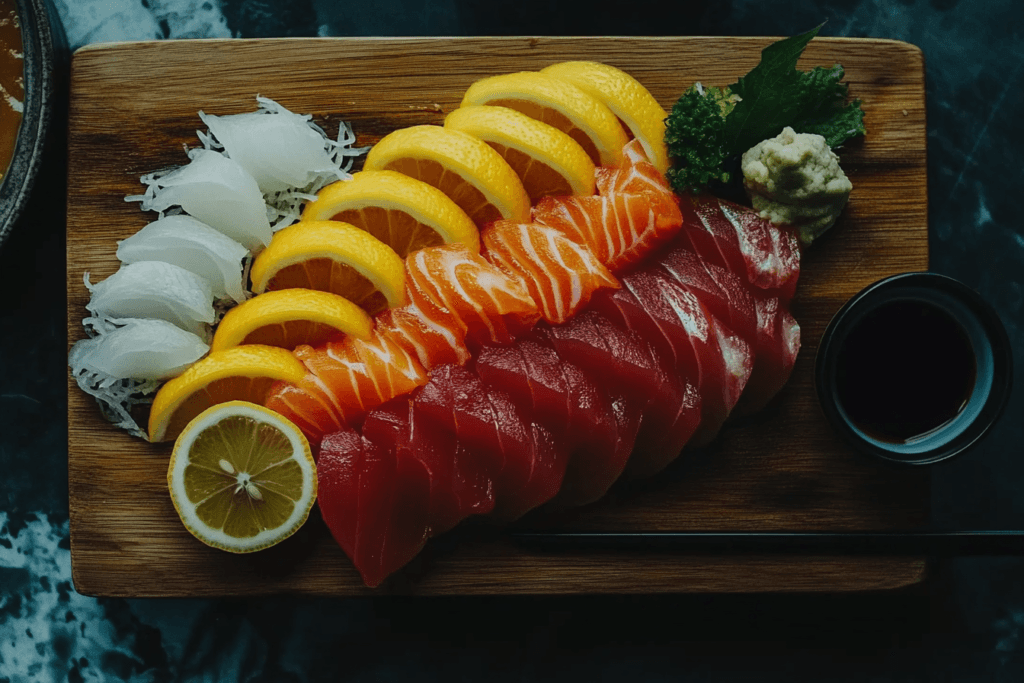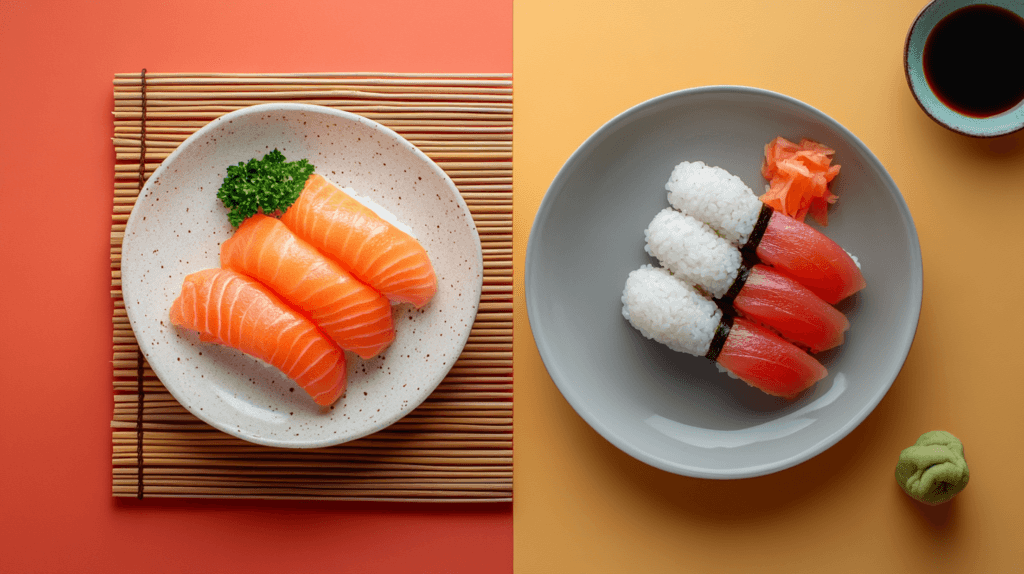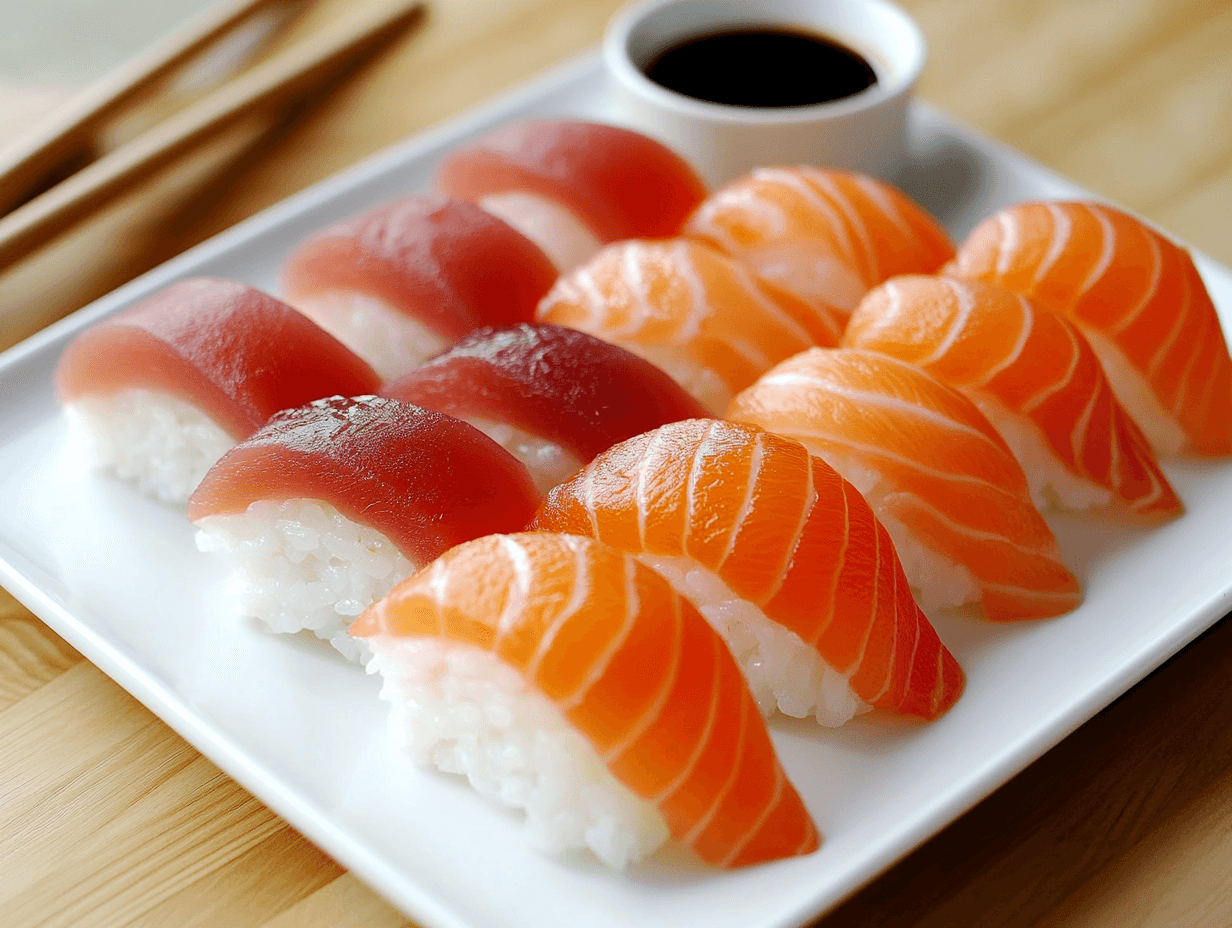Japanese cuisine has gained immense popularity worldwide, thanks to its emphasis on simplicity, fresh ingredients, and artistry. Among its many treasures, sushi stands out as a global favorite. Within this realm, sashimi and nigiri are two dishes that often spark curiosity and debate. However, what sets them apart? For both sushi connoisseurs and curious beginners, understanding these two iconic dishes can deepen your appreciation of Japanese dining. Let’s explore the nuances, cultural significance, and best ways to enjoy sashimi and nigiri to their fullest potential.Japanese cuisine has captivated food lovers everywhere, and dishes like sashimi vs nigiri are often at the center of this fascination. While they both highlight the beauty of fresh fish, their differences spark curiosity among beginners and even seasoned sushi enthusiasts. Understanding sashimi vs nigiri is essential for anyone who wants to fully appreciate Japanese dining.
What is Sashimi? Understanding Sashimi in the Sashimi vs Nigiri Debate
First and foremost, sashimi is a dish that showcases raw fish or meat in its simplest and most natural form. Unlike sushi, which always includes vinegared rice as an essential component, sashimi focuses entirely on the quality and flavor of the main ingredient. Furthermore, its name, which translates to “pierced body,” highlights the importance of the careful and precise techniques used by chefs. In addition, these slicing methods ensure a perfect balance of texture, taste, and presentation. As a result, sashimi is often seen as a true reflection of the artistry behind Japanese cuisine.
Historically, sashimi has been an important part of Japanese food culture since the Muromachi period (1336–1573). During this time, it was considered a delicacy, primarily enjoyed by samurais and the upper class. Over the centuries, however, it became a symbol of refined Japanese culinary art, celebrating minimalism and the highest standards of freshness.
When comparing sashimi vs. nigiri, the first noticeable difference is that sashimi does not include rice. Instead, it focuses solely on the fish or meat itself. Additionally, sashimi, which translates to “pierced body,” emphasizes the natural flavors and textures of thinly sliced raw fish or meat. It is usually paired with simple yet complementary sides like soy sauce, wasabi, and pickled ginger. These accompaniments enhance its taste while still allowing the purity of the main ingredient to take center stage.To explore cooking tips for seafood-based dishes, consider checking out this crab brulee recipe, which showcases innovative uses of seafood.

Types of Fish and Meat in Sashimi
When it comes to sashimi, there is a diverse selection of ingredients to enjoy. For example, some popular options include:
- Salmon (Sake): Known for its creamy, buttery texture and vibrant orange hue.
- Tuna (Maguro): Prized for its rich, bold flavor, especially fatty cuts like otoro.
- Octopus (Tako): Offers a slightly sweet taste with a chewy texture, making it unique.
- Yellowtail (Hamachi): A mild, buttery fish that melts in your mouth.
- Horse Mackerel (Aji): For those who prefer a tangy and leaner fish option.
How It’s Served
Typically, sashimi is served with carefully chosen accompaniments to complement its flavors. For instance:
- Soy Sauce: Enhances the umami profile of the fish.
- Wasabi: Provides a spicy contrast, balancing the richness of the fish.
- Pickled Ginger (Gari): Helps cleanse your palate between bites.
- Daikon Radish: Adds texture and serves as a garnish to elevate presentation.
By focusing on these simple yet effective pairings, sashimi allows the freshness of the fish to take center stage.

What is Nigiri? Defining Nigiri in the Sashimi vs Nigiri Comparison
On the other hand, nigiri is a type of sushi that combines vinegared rice with a slice of fish or seafood on top. Its name, meaning “two fingers,” refers to the small size of the rice ball, which is shaped to fit perfectly in your hand. Unlike sashimi, nigiri places equal importance on the rice and the fish, creating a balance of flavors in every bite. For inspiration on complementing your sushi meals, explore this guide to kabocha squash in Japanese cuisine, which discusses versatile ingredients like kabocha squash.
Common Nigiri Toppings
When considering toppings, nigiri offers a wide range of options to suit every taste. For example:
- Tuna (Maguro): A bold and flavorful classic.
- Salmon (Sake): Versatile, buttery, and widely loved.
- Eel (Unagi): Sweet and savory, often glazed with a soy-based sauce.
- Shrimp (Ebi): Lightly cooked with a firm, slightly sweet texture.
- Scallop (Hotate): Creamy and delicate, offering a luxurious experience.
How Nigiri is Prepared
Nigiri preparation requires both precision and artistry. To start, chefs hand-mold the rice into small mounds, ensuring the texture is firm yet fluffy. Next, they top each rice mound with a thin slice of fish, often adding a dab of wasabi or securing it with a strip of nori (seaweed). As a result, each piece of nigiri is designed to be eaten in one perfect bite.
Difference Between Sashimi and Nigiri
Although both sashimi and nigiri celebrate the beauty of fresh fish, their differences are significant. These distinctions go beyond just the inclusion of rice.
| Feature | Sashimi | Nigiri |
|---|---|---|
| Main Ingredient | Raw fish or meat | Vinegared rice topped with fish |
| Rice | Not included | Essential component |
| Presentation | Thin slices, often with garnishes | Rice mound topped with fish |
| Consumption Method | Chopsticks | Hands or chopsticks |
| Focus | Quality and flavor of the fish/meat | Harmony between rice and fish |
In addition to these differences, it’s worth noting that sashimi often highlights the fish’s raw simplicity, while nigiri offers a more balanced and filling experience.
How to Enjoy Sashimi
Enjoying sashimi is about far more than simply eating raw fish. Instead, it’s about appreciating the purity of the ingredients, as well as savoring the meticulous skill and attention to detail that go into its preparation. Furthermore, the way sashimi is served and paired with accompaniments like soy sauce and wasabi enhances the overall experience, making it both a culinary and cultural delight.
Choosing Sashimi-Grade Fish
First and foremost, you should always select sashimi grade fish, as it guarantees the fish has been handled and stored safely for raw consumption. For example, popular options include:
- Salmon: A beginner friendly choice with a rich, mild flavor.
- Tuna: Ideal for those who enjoy bold, robust tastes.
- Yellowtail: Perfect for a more indulgent, buttery texture.
Pairing Suggestions
To enhance your sashimi experience, try these pairing ideas:
- Soy Sauce and Wasabi: Use sparingly to avoid overpowering the fish’s natural flavors.
- Citrus Garnishes: A squeeze of lemon can brighten the richness of salmon or tuna.
Serving Tips
Additionally, presentation plays a crucial role in elevating the dining experience. For instance, arranging sashimi slices on a chilled platter with cucumber spirals, thinly sliced radish, or edible flowers not only enhances the visual appeal but also creates a dish that is as beautiful as it is delicious.
How to Enjoy Nigiri
Nigiri is as much about the experience of taste as it is about texture. By learning and understanding the proper way to eat it, you can fully appreciate the harmonious balance of flavors and the artistry that goes into its preparation.
Eating Etiquette
To begin, always handle nigiri with care. For instance:
- Dip the fish side—not the rice—into soy sauce to prevent oversaturation.
- Use chopsticks or your hands to pick up each piece, as both methods are acceptable.
- Eat the entire piece in one bite for a seamless flavor experience.
Popular Combinations
When choosing toppings, some delightful options include:
- Eel with Sweet Sauce: A smoky, caramelized flavor profile.
- Tuna with Wasabi: Perfect for those who love bold and spicy combinations.
- Shrimp with Lemon Zest: Offers a refreshing, tangy twist.
Nigiri’s combination of vinegared rice and fresh toppings makes it a satisfying option for any sushi lover.
Sashimi vs Nigiri in Japanese Cuisine
Both sashimi and nigiri hold deep cultural significance in Japan, reflecting the country’s rich culinary traditions. For example, sashimi is frequently served during traditional celebrations or as part of a kaiseki meal, symbolizing respect, elegance, and hospitality. On the other hand, nigiri is a staple of casual sushi dining, showcasing the artistry and precision of sushi chefs in every carefully crafted bite.
Moreover, regional variations add even more depth to these iconic dishes. In Tokyo, for instance, nigiri often features richer, oilier fish varieties enhanced by the bold flavors of soy sauce. Meanwhile, sashimi in Osaka tends to highlight local seafood specialties, emphasizing freshness and regional ingredients. These distinctions not only make each dining experience unique but also offer a glimpse into the diverse culinary landscape of Japan.

Making Sashimi and Nigiri at Home: A Sashimi vs Nigiri Guide
Although preparing sashimi and nigiri at home might seem daunting, with the right tools and techniques, it’s an achievable—and rewarding—experience.
Essential Tools
For starters, you’ll need:
- Sushi Knife (Yanagiba): Designed for precise, clean cuts.
- Cutting Board: Use a non-porous surface to maintain hygiene.
- Fresh Fish: Always opt for sashimi grade to ensure quality and safety.
Step-by-Step Instructions
- Sashimi: Begin by slicing the fish against the grain into thin, even pieces. Arrange them beautifully on a plate with garnishes.
- Nigiri: Shape small rice mounds by hand, add a dab of wasabi, and place the fish on top. You can secure the fish with a thin strip of nori if desired.
By following these steps, you’ll not only gain confidence in your cooking skills but also be able to recreate restaurant quality dishes right in your own kitchen. Furthermore, mastering these techniques allows you to enjoy authentic flavors without needing to dine out. For more ideas on Japanese-inspired dishes, consider this recipe for preparing Japanese-inspired soups and broths, like Caldo de Pollo.
FAQs about Sashimi vs Nigiri
What is the difference between sashimi and nigiri?
Sashimi consists of thinly sliced raw fish or meat served on its own without rice, highlighting the purity and flavor of the main ingredient. In contrast, nigiri features a small hand formed mound of vinegared rice topped with a slice of fish, combining textures and flavors for a more balanced bite.
Why is nigiri cheaper than sashimi?
Nigiri is often more affordable than sashimi because it includes vinegared rice, which means less fish is required for each serving, making it a cost effective option.
What are the three main types of sushi?
The three main types of sushi are nigiri, which features hand formed rice topped with fish or other ingredients; sashimi, which is thinly sliced raw fish served without rice; and maki, which consists of rolled sushi wrapped in seaweed, often with rice and various fillings.
Is nigiri technically sushi?
Yes, nigiri is considered a type of sushi because it incorporates vinegared rice, which is an essential element of all sushi dishes.
Conclusion
Sashimi and nigiri are two cornerstones of Japanese cuisine, each offering a distinctive way to enjoy fresh fish and seafood. While the comparison of sashimi vs nigiri may seem straightforward at first, understanding their unique characteristics can significantly enhance your appreciation for the artistry behind these beloved dishes. For instance, sashimi highlights the purity of raw fish, allowing its natural flavors to shine with minimal interference. On the other hand, nigiri combines vinegared rice and carefully selected toppings, creating a more balanced and satisfying experience.
Whether you are a beginner exploring sushi for the first time or a seasoned enthusiast seeking to expand your knowledge, both sashimi and nigiri have something special to offer. Furthermore, by learning how to select, eat, and even prepare these dishes at home, you can develop a deeper connection to Japanese culinary traditions. Therefore, the next time you visit a sushi restaurant or plan a Japanese-inspired dinner, confidently decide between sashimi and nigiri—or, even better, treat yourself to the best of both worlds!

